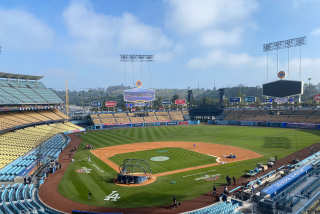Calculating future revenue from TV and land development is far from easy for Dodgers
- Share via
Jamie McCourt wants a percentage share of the revenue the Dodgers might generate in coming years from television and land development, but calculating what that revenue might be is far from simple.
The Dodgers have explored launching two cable sports channels in 2014, one in English and one in Spanish, similar to outlets owned by the New York Yankees (the YES network) and the Boston Red Sox ( NESN).
According to court filings, the Dodgers’ net television revenue is projected to jump from $41 million in 2013, the final year of the current contract with Fox, to $158 million in 2014 and $235 million in 2018. (The Spanish channel is not included in the projections.)
The YES network is projected to turn a $198-million profit this year, according to media analysts SNL Kagan.
Neal Pilson, the former president of CBS Sports, said he could not evaluate the Dodgers’ prospects for cable success without knowing whether the team might sign the Lakers, Clippers, Kings or Ducks to provide winter programming or partner with Fox, Time Warner or Comcast to cut expenses and use existing channel space.
The Dodgers’ projections call for charging cable companies $3 per subscriber, per month. YES charges $2.62 this year, according to SNL Kagan, so Pilson said the Dodgers might be aiming high.
Pilson did note the Dodgers ranked 26th among the 30 major league teams in local cable ratings, according to Sports Business Journal, which could depress the projected advertising revenue and thus make the Dodgers’ profit projections overly high.
“If your ratings are what they are, I’d be surprised if they could generate that much,” Pilson said.
Court papers also have revealed the Dodgers’ interest in developing up to a million square feet of the Dodger Stadium parking lot, with an NFL stadium, homes, offices and shops among the options.
City Councilman Ed Reyes, whose district includes Dodger Stadium, said no such large-scale development could begin without lengthy discussions on how the Dodgers would ease the effects on surrounding neighborhoods, freeways, bus and rail lines and water and sewer systems.
“Those are the layers that enable our neighborhoods to function,” Reyes said.
Without a long list of city approvals — let alone all the financing for construction — the Dodgers basically have parking lots.
To assign a large value to the land at this point is a theoretical exercise, according to John Cushman, chairman of Cushman and Wakefield and a major player in downtown development: “The land has very little value,” Cushman said, “until you have entitlements.”
bill.shaikin@latimes.com
More to Read
Are you a true-blue fan?
Get our Dodgers Dugout newsletter for insights, news and much more.
You may occasionally receive promotional content from the Los Angeles Times.











